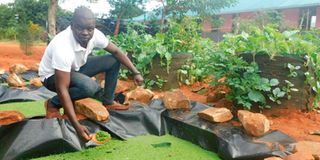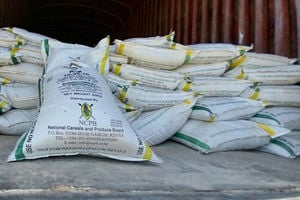Aquatic fern plant brings relief to poultry keepers struggling with high cost of feeds

Victor Mwamuye harvests mature azolla plants to feed chicken in Kilifi County.
What you need to know:
- The plant provides organic mulching for crops and hinders weed development as it maintains the soil moisture for a long time once applied.
- Some of the challenges that come with cultivating the fern is that sometimes frogs invade the ponds if left open.
A few kilometres from Pwani University in Kilifi County, one finds Kaembeni Child Development Centre.
Inside the institution’s compound, which is populated by old cashew nut trees, sits a quarter-acre piece of land that hosts a curious plant.
The green plant is known as azolla, a genus of seven species of aquatic ferns in the family Salviniaceae. The institution grows the fern in several ponds.
Victor Mwamuye, the project director at the centre, explains that they grow the plant to feed their chickens and for sale to livestock farmers, especially those who keep rabbits, pigs, cattle and poultry.
Mwamuye recounts that he started the project in January, after seeing a message posted on WhatsApp by a Zambian farmer about growing the crop.
“I read the message at the right time because then, our members were grappling with high cost of feeds,” says the 30-year-old.
“I saw an opportunity in azolla cultivation since it was going to bring relief to our members in Mwaera sub-location, Ganze sub county.”
Mwamuye, who graduated from Technical University of Mombasa with a Bachelor of Business Administration degree, accounting option, says he convinced Kenya Assembly of God Kaembeni Church, their sponsors to support the programme.
“We had donated 25 chickens each to our 20 caregivers to boost their livelihoods but feeds were a challenge,” he says, noting that they have 28 chickens for demonstration at the centre.
To start growing the fern, members were trained by an expert on cultivation and management and then they dug three ponds at the institution.

The azolla plant.
The ponds were constructed under a shade, which is the ideal site, because the tree shields azolla from exposure to too much sunlight that can lead to drying.
Their ponds measure 3 by 2 by 1 metre, he says.
The ponds are dug and then the soil is levelled to provide an even surface to spread a dam liner sheet to prevent the loss of water after filling.
“Once done, cow dung that is less than five days old is mixed with superphosphate and poured into the pond,” explains Mwamuye.
Then water is filled into the pond to 10cm high, providing an adequate floating surface for the Azolla plant.
The pond should be left for three days to settle and during this time, any dirt should be removed.
Three days later, azolla culture is introduced into the pond by rubbing it in the hands gently to break it into smaller pieces for quick multiplication, explains Mwamuye.
“It matures after 14 days, where it is ready for consumption by livestock. But at harvest, it must be cleaned to remove cow dung smell and dirt before it is given to livestock in its raw form.”
The initial investment for the three ponds was 5kg of azolla seeds bought from a farmer in Kiambu at Sh1,000 and training Sh20,000, says Mwamuye, noting they are giving out members azolla for free.
The azolla plant, according to Mwamuye, is a free-floating aquatic fern that can be fed to poultry, fish, pigs, and cattle. It can also be used as a bio-fertiliser.
Organic mulching for crops
“The plant is easily digestible and is a nitrogen-fixer with high nutrient value since it has high protein, vitamins, and amino acids that are recommended for livestock development.”
The plant provides organic mulching for crops and hinders weed development as it maintains the soil moisture for a long time once applied.
Mwanuye says that a 3 by 1 by 1 metre pond can produce a kilo of feeds in 14 days, which is harvested after every three days.
He advises that after every 10 days, 20 per cent of the water should be drained from the ponds, and fresh added to reduce nitrogen from accumulating in the pond.
“The ferns should be changed every six months for proper growth and for commercial production, a concrete tank can be built to secure the weeds,” he says.
Clarence Kazungu, 43, who keeps 20 chickens says using azolla has helped her cut cost of feeds.
Some of the challenges that come with cultivating the fern is that sometimes frogs invade the ponds if left open, and during the dry season, water supply can be a challenge.
Agriculturalist Baha Nguma says that growing ferns is a cost-effective way of helping farmers get feeds for their livestock.
“A farmer can optimise production and at the same time use less water to grow the feeds,” Nguma adds.
He notes the crop can be planted anywhere provided the temperatures are between 18 to 28 degree centigrade. On areas with temperatures above 35 degrees shades can be improvised





